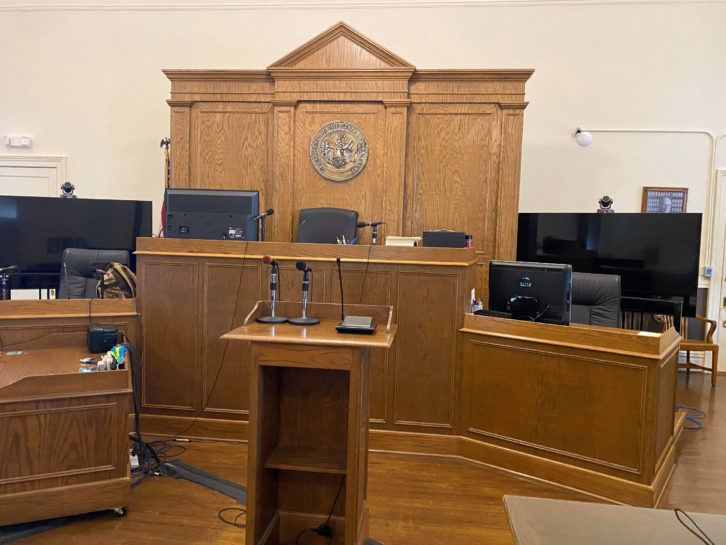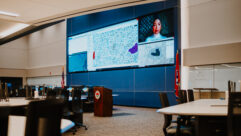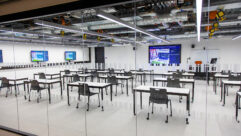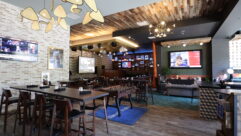The Covid-19 pandemic has disrupted virtually every aspect of life, from education to business to sports, all sectors whose plights received substantial coverage in the media. But equally disordered were justice systems, including White County’s longtime hub: the courthouse, the site of adjudications ranging from speeding tickets to homicides.
The sudden shift of court proceedings from in-person to online was perhaps the American legal system’s greatest single disruption in its nearly 250-year history. And as a significant facilitator of this historical transformation, AV over IP systems offer courthouse AV designers a simplified and user-friendly approach to a fully online courtroom experience, with all of the necessary confidentiality and privacy intact.

White County Courthouse in Searcy, Arkansas, needed just such a system. They contacted the AV professionals at locally-based Fortress Audio Video and Surveillance to install a comprehensive custom system to bring the courthouse’s myriad functions into a virtual realm. Based on the Key Digital Courtroom Communications System KD-CCS, the new setup placed AV-over-IP encoders and decoders at each participant’s table, allowing every position access to the full range of digital data necessary to assure efficient proceedings. Unlike traditional AV systems, the KD-CCS does not require a centralized equipment rack, making it especially ideal for installation in existing courtrooms; instead, the system runs smoothly via a managed-network switch and provides users with familiar PC interface control software to route video content and camera feeds.

The White County Courthouse now has the ability to route each participant’s voice, and the audio and video from camera feeds and shared laptop content, for local and remote activities. The KD-CCS system is as user-friendly as it is powerful: White County legislative officials as well as attorneys and judges are all able to use the system without need for any IT assistance.
The KD-CCS system consists of a request button for each participant, KD-CAMUSB 1080p PTZ cameras, push-to-talk USB microphones, KD-IP1022ENC and KD-IP1022DEC 4K AV-over-IP encoders and decoders, KD-RMPC mini computers, a Linksys LGS328MPC managed network switch, and PC control software for the operator (offering AV routing of each participant to a single participant or to all participants, as well as PTZ camera control). Key Digital Management Software (KDMS) provides an intuitive GUI designed for an optimized user-friendly experience. At the heart of the installation is Key Digital’s pre-configured AV over IP foundation, with its KD-IP1022 encoders for camera and laptop capture via HDMI and a decoder for each participant’s monitor. Key Digital’s KD-CAMUSB provides adjustable PTZ and preset control at each station. With the press of a KDMS button, participants can change from camera view to laptop share. The audio portion provides two-way audio via USB microphones for public and private communications and uses the display’s speaker for audio or may be integrated with an amplifier or assisted listening system if desired.
“Judicial functions must balance the responsibility of protecting the health and safety of judges, staff, litigants, and all other visitors while minimizing interruptions to justice services,” declared CGL, the world’s largest and most comprehensive criminal-justice consulting firm, in a white paper on courthouse planning during the pandemic. Citing transformative adaptations such as the more widespread use of video technology for conferences, depositions and court proceedings, and low-touch and no-touch audio-visual technology, CGL went on to say, “Inside the courtroom, presentation and management of evidence through large monitors and projectors have transformed the process of justice. Digital graphics, audio and video recordings, and sensitive materials can all be made visible and accessible to jurors and the court through individual or group presentation screens, in person or virtually.”
The legal maxim “Justice delayed is justice denied” has never been more true, and those who work at the pursuit of justice at the White County Courthouse report that they’re pleased that the KD-CCS system is more versatile and user-friendly than they had believed possible, and has enabled them to keep the wheels of justice turning as smoothly and efficiently as necessary, no matter what the pandemic throws at them.
For more information:
KD-CCS Courtroom Communications System










